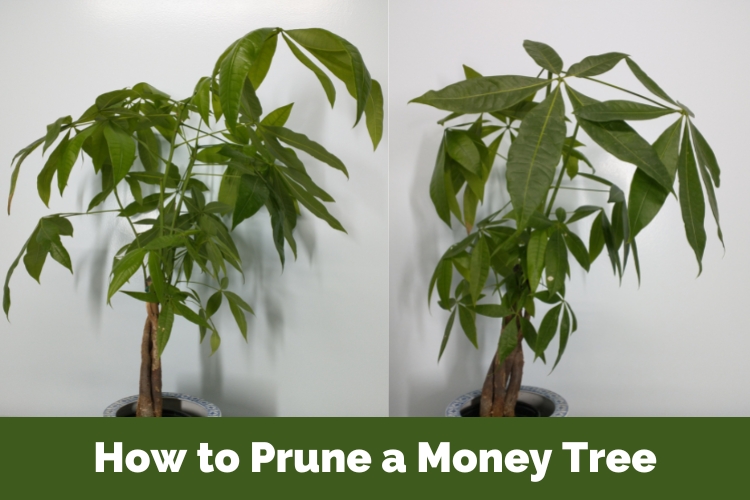Money trees, known officially as Pachira aquatica, are great houseplants that really bring a jungle feel to the indoors. But they are true trees that can reach heights of 60 feet in the wild- and while they’ll likely max out at about 6 feet tall as a houseplant, most of us don’t want one that large. I know I don’t, so that’s where pruning comes in.
How to prune a money tree? Money trees need both structural and routine pruning. Structural pruning involves removing overgrown or awkward branches to create a balanced, attractive shape. Routine pruning involves removing smaller portions from the tree, including old, dead leaves and leggy branch tips.
I’ve had a money tree for several years and have learned through what works (and doesn’t!) to maintain and care for these plants. I’ve found that my money tree gets pretty unruly and overgrown every few months, so it needs regular pruning to remove dead or deformed growth and encourage new growth and a pleasing shape.
Today, I will be sharing my personal experience and knowledge on how to prune a money tree, from assessing its overall shape to deciding what you need to remove and where to cut.
Let’s get started!
Table of Contents
Structural vs Routine Money Tree Pruning
Not all pruning is the same, and depending on your money tree’s current state and your overall goals, one of these two methods is in order:
- Structural pruning has a larger scope: removing plant material that is somehow defective or that is growing in the wrong direction, or changing the shape more dramatically. This type of pruning often involves more and larger cuts but is not done as often as routine pruning.
- Routine pruning is concerned with smaller cuts that support the basic health and growth habit of the tree. Routine pruning includes things like removing dead or weak plant material, as well as removing new growth to maintain a certain size if you want to keep your money tree small. All this helps the tree to look nice and stay healthy.
Supplies Needed to Prune a Money Tree
There’s a very short list of supplies for pruning a money tree:
- Plant shears or sharp scissors
- Disinfectant for cleaning your cutting blades- I like to use isopropyl alcohol
How to Identify Money Tree Nodes
Nodes are essentially specialized tissue that grows new leaves and stems. On a money tree, these dormant growing points look like small round bumps where the leave fronds branch off the main stem.
Here’s a stem with several node junctures:
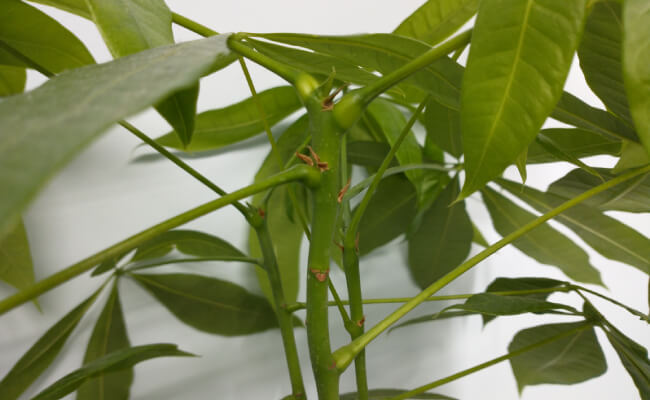
You need to know how to identify nodes because it can change your pruning strategy, based on your overall goal. If you cut above a node, that node will then start to grow new material, but if you cut a stem below a node, it won’t. In other words, it’s a way of encouraging or discouraging new growth.
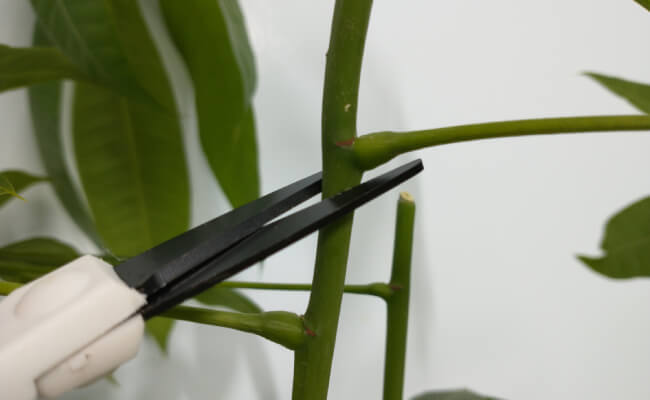
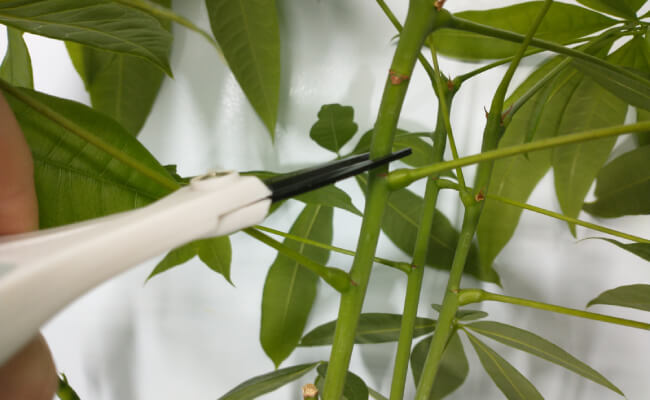
If you want to propagate your money tree from your trimmings, it’s easy to do. Take a cutting from a sturdy stem with one or more nodes towards the bottom, and place that end in a pot of soil or glass of water. They will form new roots from the nodes, and you can then pot up Money Tree 2.0.
How to Prune a Money Tree: 5 Steps
Now let’s shift gears into the actual process of how to trim a money tree. Here’s what I’ll be covering:
- Assess the starting shape and decide on your goal
- Start with larger branches
- Assess the shape frequently
- Don’t prune off too much at once
- Pinch off new growth buds
1. Assess the Starting Shape and Decide on Your Goal
Before making any cuts, take the time to look at the entire tree to figure out your goal. What are you pruning for? Pruning cuts are permanent, so you need to have a good idea of what you want the plant to look like at the end of things.
- If the tree is outgrowing your space, remove material from all sides.
- If it’s too tall, take some off the top.
- If it’s too bushy, cut back some side branches.
- If branches or stems are crossing and rubbing, remove at least one of the offenders.
So, before pruning money tree branches, look at the plant and think about what you really want to accomplish as you trim your money tree. Remove height? Trim up the sides? Make it look less dense? You can even use string or twist ties to mark branches you know you’ll want to remove.
My money tree doesn’t look terrible, but I’d like to keep it a bit smaller than it’s gotten over the last few months:
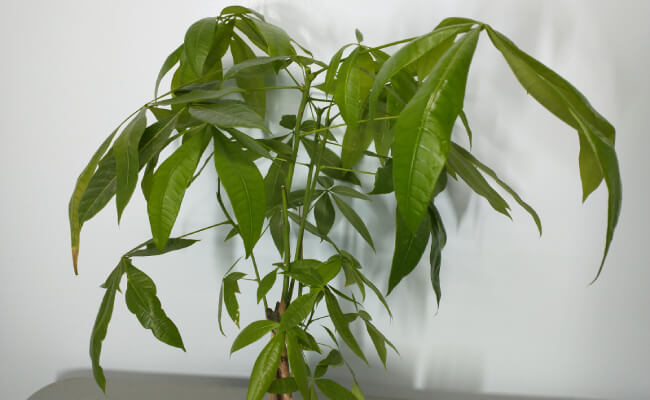
2. Start With the Larger Branches
Remove any yellowing or dead branches/leaves first. These have to go anyway, and cutting them off may move you closer to your end goal than you think.
Next, set your sights on the larger branches first. On large money trees, this might be quite a few branches, but on smaller plants, just a few.
- If you want to trigger new growth, make these cuts about ½ inch above the node, and angle your cut to roughly 45 degrees.
- If you want to slow growth, cut the branch all the way back to the main stem–but don’t cut into the main stem.
Once you’ve done that, you can make smaller cuts to achieve whatever look you want, such as removing some smaller branches or parts of them to thin the canopy. You can also trim branches from the bottom to expose more of the very sculptural stem.
3. Assess the Shape Frequently
I’ve had this unfortunate experience a few times- I’m so focused on shaping a specific section of a plant that I forget about the overall shape. That has left me with lop-sided, asymmetrical plants that definitely don’t look their best.
While plants will usually forgive us for this mistake and eventually fill in sparse areas, that can take a while. So make it a point to avoid the problem altogether by stopping often and checking where you are on the grand scheme.
After you make a few cuts, step back and look at how that has changed the plant overall. This helps you keep from pruning off too much from any one part of the tree and helps guide your next cuts.
4. Don’t Prune Off Too Much at Once
Generally when it comes to pruning anything, including money trees, you don’t want to prune away more than one-third of the plant material at a time. If you take more than this, the plant may become stressed and respond in several suboptimal ways:
- Leaf yellowing
- Leaf drop
- Stunted or no new growth
When in doubt, you’re better off leaving that questionable growth on the plant for the time being. You can always come back to it in a few weeks.
5. Pinch Off New Growth Buds
If you want to slow down the growth of the tree, remove the new growth on the ends of the branches. The new growth points look like pointed buds:

You can also trim back the branches to a leaf juncture, which will reduce the size and growth of the money tree.
How to Prune Money Tree Roots
You may want to prune your money tree’s roots for two reasons:
- To keep the root ball, and thus the rest of the plant, smaller in size.
- To remove dead, decaying root material from bacterial or fungal infection, known as root rot.
Here’s how it works:
- Cover your work surface with newspaper or old sheets to make it easier to clean up.
- Lay your money tree on its side.
- Gently work the root ball free. Don’t pull on the stem; instead, use a plastic knife to loosen the edges of the soil, and push up from the drainage holes.
- Once the root ball is free, carefully examine it for signs of root rot. Healthy live roots will be white or beige and be firm to the touch. Dead or dying roots will be a slimy brown and will feel mushy.
- Cut away any dead roots with sanitized shears.
- To prune roots for size, identify the largest roots. Often these are the roots at the base of the root ball that have started circling the pot. Cut off the excess length.
- Then you can place the plant back in the pot and fill in the sides with fresh potting soil.
When Should You Prune a Money Tree?
I love the look of a money tree- but I also want to keep that potential for wild growth under control. In my experience, a money tree needs a good pruning every year unless it’s still a young, immature plant.
The best time of year for a “big prune” (where you remove branches and a lot of leaf material) is spring or summer when the plant is in its natural growing season. Routine pruning that takes care of dead bits and a few leaves here and there can be done at any time.
A side benefit of pruning in the spring and summer is that it is also a great time to propagate money tree cuttings because they are already in active growing mode.
You may find that after pruning your money tree has some stems that have outgrown the braiding done when the plant was young. Not to worry- you can continue the braided look yourself, and this video from Anna’s Violets is a great demonstration:
Frequently Asked Questions about How to Prune a Money Tree
Final Thoughts
Once you’ve decided on your goal shape and have identified node locations that you can cut above or below, don’t be afraid to prune your plant. In my experience, money trees are quite forgiving and should put out new growth quickly, even if you make a questionable cut.
I hope you’ve found these tips useful and you can now confidently go out and prune that money tree!
I’d love to hear from you! Do you have any other questions about how to prune a money tree or any helpful tips to share? I believe that learning from one another’s experiences is the best way to learn as a community, so please feel free to post your comments below!

